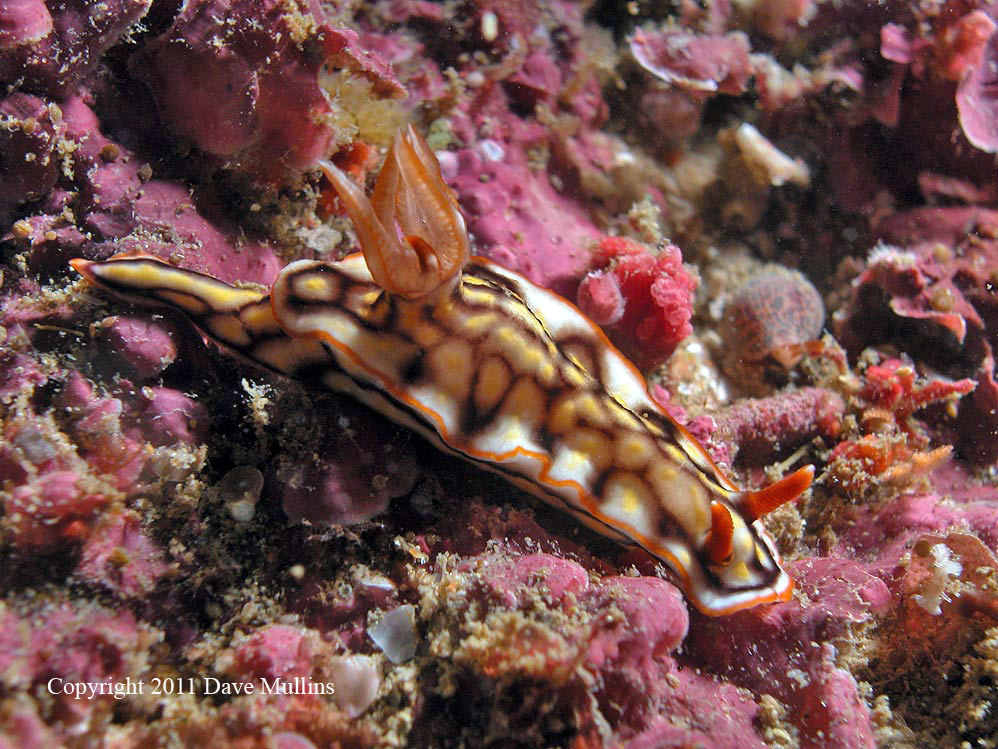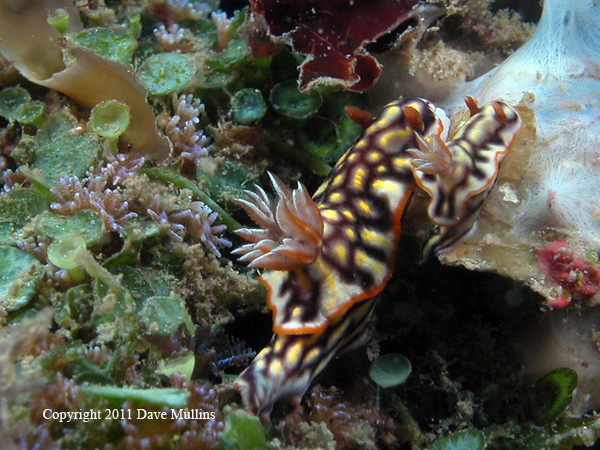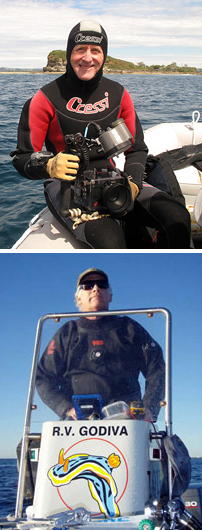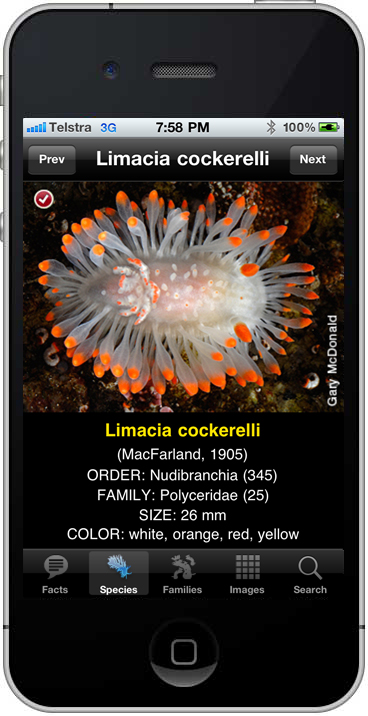 |
Hypselodoris jacksoni
Image courtesy of Dave MullinsGneering Shoals, Mooloolaba, Queensland, Australia. Queensland, Australia
Canon G10 in Ikelite housing with one Inon Z220 strobe
Copyright 2011, Dave Mullins
Hypselodoris jacksoni feeding
 |
Hypselodoris jacksoni Wilson & Willan, 2007
Hypselodoris jacksoni is a Chromodorididae species of nudibranch with a fairly limited distribution in the south-western Pacific Ocean being reported from New Caledonia, Norfolk Island, Lord Howe Island and the subtropical and temperate waters of the Australian east coast. In our particular survey area, covering the Sunshine Coast of Southern Queensland, Australia we have classified its occurrence as "very common" due to the fact that it is observed upon almost every dive. Even though it is commonly sighted it was not described until 2007, perhaps due to this limited distribution combined with its occasional variable colouration. This is a medium sized nudibranch usually presenting between 20 to 35 mm although we have recorded specimens up to 65 mm in length. When crawling the tail is quite long. It has the "typical" high-sided Hypselodoris look about it. The mantle has a narrow overlap along the sides of the high walled body although this widens anteriorly. The gill pocket sheath rises quite distinctly above the surrounding mantle and the simple, white gills, triangular in cross section with red-orange lines on the outer axes, form a circle around the anus. The lamellate rhinophores are tall, red-orange in colour with a white tip. The colouration of Hypselodoris jacksoni is very distinctive though variable. The most common presentation is of a distinct reticulum of dark brown or black in filled with yellow spots that are surrounded by white on the mantle, foot and tail. This reticulum has three recognizable longitudinal lines on the mantle of which the lateral-most form hemispherical loops towards the mantle margin. There is a consistently thin, red-orange band on the mantle margin and tail together with a submarginal opaque white band that extends inwards to fill the previously mentioned loops of the reticulum. Defensive glands are present around the entire mantle margin being largest and most dense posterior to the gills. Whilst most specimens have a striking intensity of colour and pattern others have a less distinct or much closer reticulation pattern together with a faded appearance to the colours. The orange to pink spawn is laid as an upright crenulated spiral and the hatched veligers show lecithotrophic development. Our sightings are most usually of individual specimens but occasionally we will find groups of up to 7 all competing for a share of a single, doomed sponge colony - a "feeding frenzy" of the sea slug kind. The sponges upon which they prey have been identified as belonging to the genus Euryspongia of the Dysideidae family.
|
References:
Wilson N. 2002. Egg Masses of Chromodorid Nudibranchs, Malacologia, 2002,44(2): 289-305.
Cobb & Willan 2006. Undersea Jewels, ABRS, Canberra.
Wilson & Willan 2007. Hypselodoris jacksoni, a new species from the south-western Pacific Ocean, with a discussion on intraspecific variation in mantle glands in Chromodoris willani Rudman, 1982, Zootaxa 1549: 29-42 (2007).
Mullins D. (Message in) & Rudman W. (Comment) 2007. Hypselodoris jacksoni Message #20572 Sea Slug Forum, Australian Museum, Sydney.
Rudman, W.B., 2007 (August 28)
Hypselodoris jacksoni Wilson & Willan, 2007. [In] Sea Slug Forum. Australian Museum, Sydney.
Queensland, Australia
Sept., 2011
Send Dave email at marineimages@hotmail.com
WEBMASTER'S NOTES:
John Greenamyer of Running Springs, California was able to video Hypselodoris jacksoni in the Milne Bay area of PNG last November. This sighting expands the known range of Hypselodoris jacksoni, which probably comes as no great surprise, given the proximity of the two areas (Queensland and PNG)!
Gary Cobb and Dave Mullins
on location in Queensland, Australia
 |
NUDIBRANCH ID iPHONE APP A dedicated Nudibranch Identification Guide has been developed for the iPhone. Capitalizing on the popularity, ease of use and high-resolution touch screen of the iPhone, this innovative field guide does not require access to the carrier network or Internet. The first in this series of iPhone Apps, with 700 species of Nudibranch (Sea Slug) from the Central Indo Pacific Region where marine diversity is at its greatest are represented with stunning photographs sourced from 50 underwater photographers from around the globe, has already been released and has proven extremely popular. Dedicated diver, underwater photographer and art director Gary Cobb of the Sunshine Coast, Queensland, Australia has devoted over 8 years to his passion for these amazingly diverse and alluring creatures. He and David Mullins dive up to 4 times a week, weather permitting, and have catalogued in the local area, 469 species. "I wanted to tackle the challenge of adding to our Nudibranch research and website by way of the new iPhone App technology but also expanding our finds to cover the entire World." Gary said. "In this way exceptional field guides are produced whereby the user can check off species and create their own lists. First I had to learn how to build with this new iPhone App technology, and then contact the photographers to request permission to use their images. The result was overwhelming. For people who appreciate these creatures the App couldn't come soon enough." Photographers who have donated their images are acknowledged on the Info page and on all photos. The second App in the series is in the final stages and testing. Soon marine scientists, naturalists, students, divers and the world-wide community of Nudibranch enthusiasts will be able to view 420 species that live in the Eastern Pacific region from Alaska to the tip of Chile. All of the Apps include amazing color photographs, essential facts, scientific names, author and date, scientific classification, size and colors. The Facts page lists the orders and the Families page the families, with a description of what makes each unique. This is an Identification Guide by Nudibranch lovers for Nudibranch lovers.
|
 |
Features of the East Pacific App:
1. Nudibranch Facts - Information about Nudibranchs, what they are and what makes them so interesting and unique in the underwater world. |
3. Families - Descriptions of the 56 Families represented in this App providing external morphology information that allows comparison and contrast between the Families.
4. Images - The Images Gallery is a scrollable screen of Nudibranch thumbnails. They are presented 4 across the screen providing 24 "at a glance" images.
5. Search - Full search ability. The search capability of this App is both convenient and comprehensive. The search is species centric displaying a list of Species in response to the search input based upon any of Order, Family, Genus, Author, Date, Size, Color, Checked off species or even just a Species name.
6. Information - About the App and tips on how to get the most out it as well as tips on getting the best search and acknowledgments.
7. The ability to check (tick) off Species and to be able to email the List.
8. Navigation around the App is extremely fast, logical and intuitive.
The Eastern Pacific App is a stand alone Application built for the Apple iPhone and does not require an Internet connection. It will be purchased for $10.99AUD from the iTunes App store when completed.
Gary is currently working on Four (4) new Nudibranch ID Apps which together will cover the entire world. For more information see the Nudibranch ID App
Website
or send Gary email at gary@nudibranch.com.au
 |
